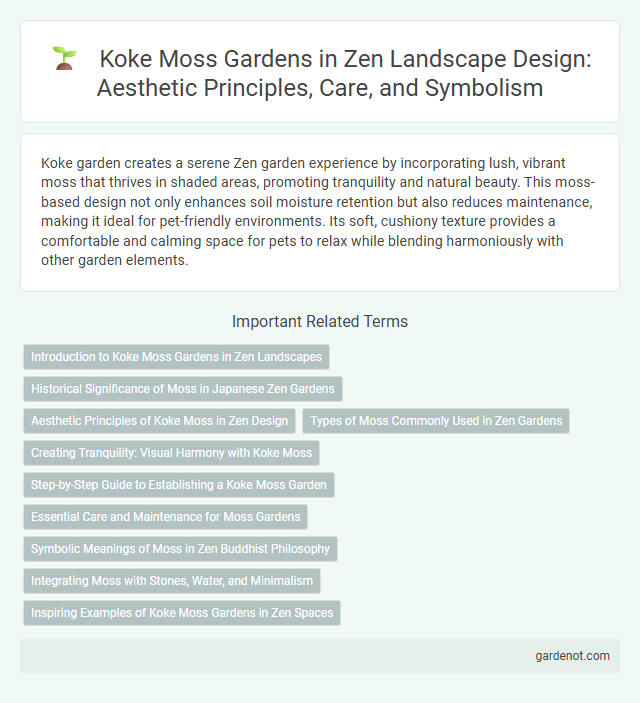Koke garden creates a serene Zen garden experience by incorporating lush, vibrant moss that thrives in shaded areas, promoting tranquility and natural beauty. This moss-based design not only enhances soil moisture retention but also reduces maintenance, making it ideal for pet-friendly environments. Its soft, cushiony texture provides a comfortable and calming space for pets to relax while blending harmoniously with other garden elements.
Introduction to Koke Moss Gardens in Zen Landscapes
Koke moss gardens are a traditional element in Zen landscapes, known for their vibrant green moss that thrives in shaded, moist environments. These gardens emphasize simplicity and natural beauty, creating a serene ambiance that promotes meditation and mindfulness. Integrating various moss species, Koke gardens maintain ecological balance and enhance the textural contrast with rocks and minimalist design in Zen aesthetics.
Historical Significance of Moss in Japanese Zen Gardens
Moss plays a pivotal role in Japanese Zen gardens, symbolizing longevity, tranquility, and natural beauty deeply rooted in centuries-old traditions. Koke gardens, renowned for their lush moss landscapes, illustrate the harmonious balance between nature and spirituality that characterizes Zen aesthetics. These moss-covered gardens preserve cultural heritage by embodying Zen principles of simplicity and mindfulness, creating serene spaces for meditation and reflection.
Aesthetic Principles of Koke Moss in Zen Design
Koke moss in Zen design embodies wabi-sabi aesthetics, emphasizing simplicity, naturalness, and imperfection to create tranquil spaces. Its soft textures and muted green hues provide a harmonious contrast to rocks and gravel, enhancing the garden's contemplative atmosphere. The careful placement of Koke moss highlights the balance between emptiness and fullness integral to Zen garden philosophy.
Types of Moss Commonly Used in Zen Gardens
Koke gardens in Zen landscapes commonly feature moss varieties such as Hypnum, Dicranum, and Leucobryum, revered for their lush texture and soothing green hues. Hypnum moss, often called sheet moss, thrives in shaded, moist environments, providing a soft carpet-like ground cover. Dicranum offers a spiky, vibrant green appearance, while Leucobryum adds a cushiony, pale contrast, creating harmonious visual balance in traditional Zen garden designs.
Creating Tranquility: Visual Harmony with Koke Moss
Koke garden, known for its lush, vibrant moss carpets, creates tranquility through visual harmony and natural textures that soothe the mind. The intricate layering of different moss species enhances the Zen garden's serene atmosphere, promoting mindfulness and calm reflection. This living green tapestry acts as a soft, living carpet, integrating seamlessly with rocks and water elements to embody peaceful simplicity.
Step-by-Step Guide to Establishing a Koke Moss Garden
Establishing a Koke Moss Garden involves selecting a shaded, humid location with acidic, well-draining soil to encourage moss growth. Begin by clearing the area of debris and invasive plants, then gently tamp the soil to create a smooth surface before laying down moss fragments or sod. Maintain consistent moisture through regular misting and protect the garden from direct sunlight and foot traffic to ensure healthy moss establishment.
Essential Care and Maintenance for Moss Gardens
Koke gardens thrive with regular moisture and indirect sunlight, essential for maintaining vibrant moss growth. Consistent misting and careful watering prevent dryness without causing waterlogging, crucial for moss health. Removing debris and trimming surrounding plants ensures optimal airflow and light penetration, promoting lush, green moss carpets.
Symbolic Meanings of Moss in Zen Buddhist Philosophy
Koke gardens, or moss gardens, hold profound symbolic meanings in Zen Buddhist philosophy, representing impermanence, tranquility, and the natural passage of time. Moss embodies simplicity and humility, reflecting the Zen ideals of mindfulness and spiritual awakening through its quiet resilience and subtle beauty. This living carpet fosters a meditative atmosphere, encouraging practitioners to embrace the present moment and the continuous cycle of growth and decay.
Integrating Moss with Stones, Water, and Minimalism
Koke gardens skillfully blend lush green moss with natural stones, creating textured landscapes that emphasize simplicity and balance. The integration of water elements enhances the serene atmosphere, reflecting Zen principles of tranquility and mindfulness. Minimalist design in Koke gardens highlights the natural beauty of moss, fostering a harmonious connection between nature and contemplative space.
Inspiring Examples of Koke Moss Gardens in Zen Spaces
Koke moss gardens exemplify the tranquil beauty and meditative essence central to Zen garden design, showcasing lush, velvety green moss that softens stone arrangements and pathways. These gardens use various moss species such as Dicranum, Hypnum, and Leucobryum to create textured landscapes that inspire mindfulness and harmony. Renowned Zen spaces like Saiho-ji in Kyoto highlight the artful integration of Koke moss, making them exemplary models of serenity and natural aesthetics.
Koke garden Infographic

 gardenot.com
gardenot.com